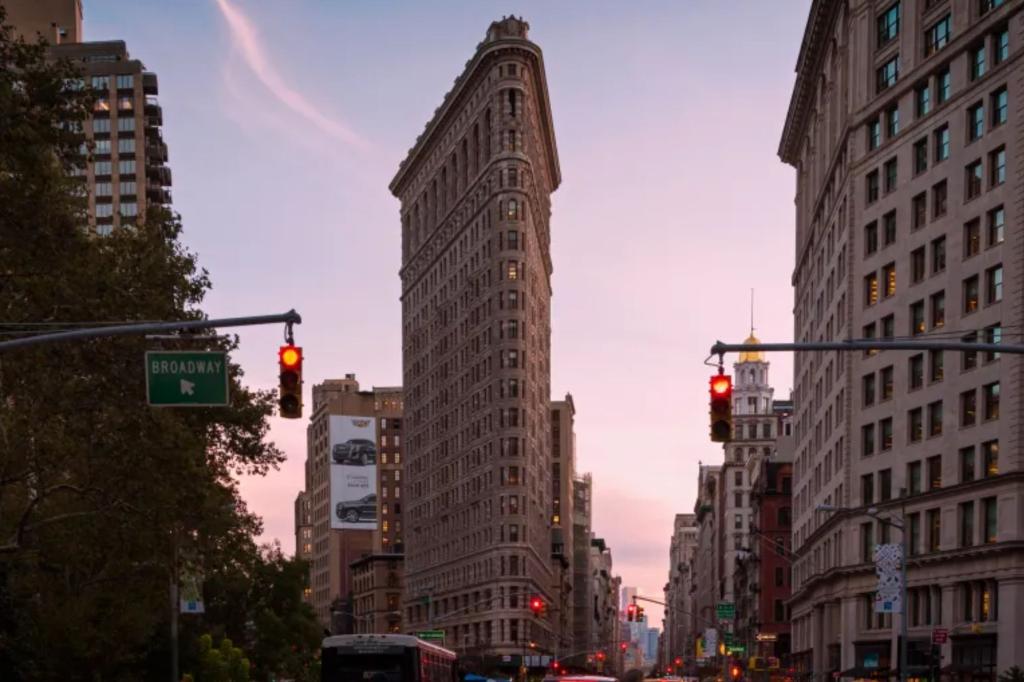The Flatiron Building is certainly one of New York City’s most recognizable landmarks — but information regarding its highly anticipated condominium conversion has been kept far from the public eye.
Now, however, some details on the hush-hush development are coming to light.
The Real Deal, citing an offering plan, reports that prices there will start just shy of $11 million and top out at $50 million.
According to that plan filed with the state attorney general, the developers — the Brodsky Organization and the Sorgente Group — are eyeing a projected sellout of roughly $375 million for the first 18 of the project’s 38 residences. (But when combined with proceeds from 38 storage lockers and six wine cellars, the total is expected to exceed $380 million.)
The Flatiron Building — one of New York’s most recognizable landmarks — is entering a new chapter as a collection of 38 luxury residences. Education Images/Universal Images Group via Getty Images
The famed building will glitter when it’s completed. Courtesy of The Flatiron Building
The priciest homes — sprawling units on the 20th and 21st floors — span more than 7,400 square feet, with each including five bedrooms and five baths.
The 21st-floor residence also offers a small outdoor terrace of 33 square feet. Lower-level three-bedroom units begin around $11 million for approximately 3,000 square feet of interior space.
Some details have even emerged on what appears to the the development’s crown jewel. A 4,600-square-foot penthouse with an unprecedented 6,600 square feet of outdoor space — the largest private terrace in the building — remains unpriced.
Once completed, the reconfigured Flatiron — which currently stands fully surrounded by scaffolding — will comprise 38 private residences in total.
To steer sales, Brodsky and Sorgente enlisted Corcoran Sunshine Marketing Group, which appointed brokers Donna Puzio and Angeli DeCecchis to lead marketing efforts.
Corcoran’s Steve Gold recently announced on Instagram that he is “first broker to secure a signed deal in this globally admired building,” signaling that sales are already underway.
A spokesperson for the project declined to elaborate or confirm the official launch timeline.
Condos start just under $11 million for a 3,000-square-foot, three-bedroom home, while the two most expensive residences — units 20 and 21 — are asking $48 million and $50 million, spanning over 7,400 square feet each. Universal Images Group via Getty Images
The landmark’s Beaux-Arts limestone and terra-cotta façade, originally designed by Daniel Burnham in 1902, is undergoing a painstaking restoration in coordination with the Landmarks Preservation Commission. Corbis/VCG via Getty Images
The redevelopment follows the property’s official $160 million acquisition last year by a group led by GFP Real Estate’s Jeffrey Gural, alongside Sorgente Group, ABS Partners and Nathan Silverstein.
Preceding that was a chaotic situation in early 2023, in which the property went up for court-ordered auction and was won by a 31-year-old man named Jacob Garlick, who placed the winning $190 million bid and failed to pay up. In a subsequent auction two months later, the current owners — who were the ones trying to get rid of the building in 2023 — won the building back.
Inside, the interiors are being crafted by Studio Sofield, the design firm behind such luxury projects as Bergdorf Goodman’s men’s store and 111 W. 57th St. Principal William Sofield is reinterpreting the landmark’s historic elements — from marble mosaics to wrought-iron details — in a contemporary idiom that complements its storied past.
The edifice is presently surrounded by scaffolding. Getty Images
The building was previously used for office space. Anne Wermiel/NY Post
Working in close consultation with the Landmarks Preservation Commission, a team of specialists has also undertaken a sweeping restoration of the building’s terra-cotta and limestone façade, including more than 1,000 new windows and thousands of individually replicated ornamental pieces.
First completed as the Fuller Building by architect Daniel Burnham, the Flatiron Building quickly became a global symbol of New York’s architectural ambition. Over the next century, it housed publishers, fashion firms and creative agencies.
The conversion marks the first time in its 120-year history that the triangular tower will be occupied as homes.
